The Good News About Alcohol And Cancer

“Only 3.5% of cancer deaths world-wide (230,000 a year) are attributable to alcohol, according to a 2006 analysis of World Health Organization data.” Feel free to skip the rest of this article. That’s all you need to know. Everything else is completely irrelevant. I’m sorry I even brought it up. In related news, go ahead and drink cheap wine. It’s not like it’s going to kill you or anything.
Sherlock Holmes And The Adventure Of The Impudent Scholars
Sherlock Holmes And The Adventure Of The Impudent Scholars
by Jenny Hendrix
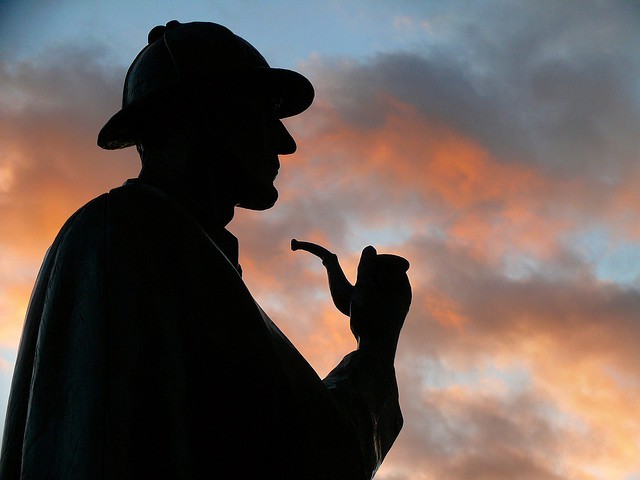
A nine-foot-tall statue of Sherlock Holmes stands outside the Marylebone exit to the Baker Street Tube station in London. Solemn and gaunt, Holmes looms over traffic in his trademark Inverness cape and deerstalker, pipe in hand. The statue, London’s first to its famous fictional denizen, was unveiled in 1999. It was primarily funded by the Abbey National Building Society, formerly of 219–229 Baker Street, which, starting in 1932, began receiving the thousands of letters mailed each year to Sherlock Holmes at his 221B Baker Street address. At one point, the society employed a full-time secretary to answer them. When in 1990, the Sherlock Holmes museum down the street (in actual fact between numbers 237 and 241) changed its address to 221B, it led to a fifteen-year dispute over which entity would have the honor of receiving Holmes’ mail. Abbey moved its headquarters in 2005, and the museum, which has recreated the flat shared by Holmes and Watson down to its tobacco-filled Persian slipper, has retained the right.
This letter appears on the museum’s website:
Dear Sherlock Holmes,
I have heard that some of the lads of London help you from time to time in solving crimes. I would like to let you know that I also am at your service. Any time you need help solving some of the cases which are connected with the United States of America, I will be there for you, especially if the case involves dinosaurs or fish, as these subjects are my specialty. Just let me know. Give my regards to Dr. Watson,
Yours sincerely,
Brandon Sellers (5 y/o).
Such is Holmes’ magnetism that it’s not only five year olds who address the detective as if he were a real figure. Indeed, Sherlock Holmes is so vivid a fiction as to have left many footprints in the realm of fact. Even his closest critics treat him as though he once lived.
Readers of Leslie Klinger’s The New Annotated Sherlock Holmes might pause over annotations that parse the details of Holmes’ life with biographical vigor (on his cocaine use: “Holmes probably purchased his supplies from either John Taylor, Chemist, at the corner of George Street and Baker Street — east side — or of Curtis and Company, No. 44, on the west side — and so only a few doors from Holmes’s rooms”); while travelers in Meiringen, Switzerland may stop to wonder at the plaque that commemorates Holmes’s defeat there of his nemesis, Professor Moriarty; and curious Googlers might well be confused by the myriad sources out there which cite Holmes’ existence as fact. Even England’s Royal Society of Chemistry was moved, in 2002, to award Holmes a posthumous honorary fellowship. In a ceremony conducted by fortuitously-named Society fellow Dr. John Watson, Holmes was recognized “for his love of chemistry and the way he wielded such knowledge for the public good,” and for his invention of forensic science in “published papers on using tobacco ashes, shapes of ears, cryptography, dating of documents, tattoos and footsteps as clues.” As one commenter observed, “That would doubtless be a good reason for awarding somebody an honorary fellowship… but Holmes wasn’t somebody — or indeed anybody.”
Sherlock Holmes, along with the faithful John H. Watson, M.D., made his debut in Sir Arthur Conan Doyle’s A Study in Scarlet, in the Beeton’s Christmas Annual of 1887. He was an immediate hit with readers, who eagerly awaited his next appearances in the Strand and Collier’s magazines, and, later, in Doyle’s novels and story collections. “I fear,” Doyle wrote, presciently, in the preface to his final collection of Sherlock Holmes tales, “that Mr. Sherlock Holmes may become like one of those popular tenors who, having outlived their time, are still tempted to make repeated farewell bows to their indulgent audiences. This must cease, and he must go the way of all flesh, material or imaginary.”

Doyle famously tried to kill Holmes off himself, considering the stories to be a fatuous distraction from his more serious historical fiction and writing on spiritualism. When Doyle had Holmes pitched off the edge of Reichenbach Falls to certain doom, the streets of London filled with men in black armbands, demanding a revocation of the deadly deed. Nine years later, Doyle finally and begrudgingly acquiesced, reanimating Holmes in “The Adventure of the Empty House”. The Holmes stories continued for another 24 years — cases were still being “uncovered” even after the great detective had been retired to a bee farm in the Sussex Downs. And, independent of his author’s plans, Holmes has never stayed quiescent long — many, many more words have been written on him since his appearance than there are in all of Doyle’s tales. Holmes will be a gloriously un-round 124 this month, and yet the famous detective — bohemian, snob, genius logician, and drug addict — is by now so near and dear and inextricable to the culture that the excuse of an important anniversary isn’t necessary to reawaken interest in the series. A sprinkling of appreciations appear every so often almost as a matter of nature, as if the cultural cloud had reached its saturation point and been obliged to let off pressure: according to Amazon, the past 90 days alone saw the publication of some 390-odd reissues, sequels, pastiches and critical appraisals. Upcoming releases include Laurie King and Leslie Klinger’s anthology, A Study in Sherlock: Stories Inspired by the Holmes Canon; David Acord’s Success Secrets of Sherlock Holmes: Life Lessons from the Master Detective; and Sherlock Holmes and Philosophy: The Footprints of a Giant Mind, edited by Josef Steiff. “Sherlock,” the BBC’s contemporary adaptation of the series, will move into its second season in early 2012; Sherlock Holmes: A Game of Shadows, the second film to star Robert Downey, Jr. and Jude Law as a rather steampunk-ish Holmes and Watson, is slated for release this December.
Après Sherlock, le deluge. Still, one wonders, why?
***
In On Conan Doyle: Or, The Whole Art of Storytelling, a memoir-esque journey through that author’s work, Washington Post book critic Michael Dirda describes the “fearful pleasure” that permeates the entirety of Doyle’s Sherlock Holmes canon. The pure romance of the text conjures a gas-lit world of hansom cabs and foggy moors that are catnip to the imagination. It’s a pleasure so many of us know that the mere mention of Holmes’s name provokes a Proust-with-Madeleine-like reflex, making it tempting to respond to a book like Dirda’s with a memoir of one’s own.
The phrase “Elementary, my dear Watson” — funnier now that I know it doesn’t appear even once in Doyle’s stories — was a standby of my childhood, and Dr. Watson’s description, in “The Final Problem,” of two sets of footprints leading down the path and none coming back might have been my earliest understanding of death. There was also that schoolyard retort, “No shit, Sherlock,” which is nothing if not a marker of the detective’s resonance — a blip on the playground’s keen cultural radar. I’m not sure that I know of any other fictional character so recognizable. In our modern times he is almost a brand name, his attributes (pipe, deerstalker) able to instantly telegraph extra-literary meaning. Though the phenomenon is not an unusual one today (witness H&M;’s new Lisbeth Salander clothing line), Sherlock Holmes has perhaps the most pervasive character brand of all. He might just be the Kleenex of detection.
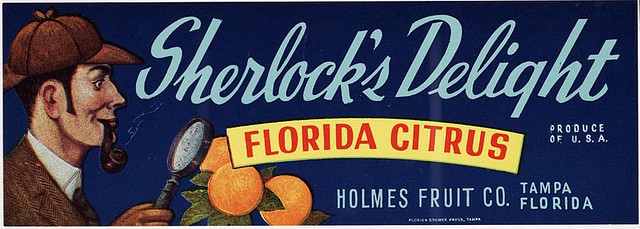
The universe of Sherlock Holmes has expanded well beyond the confines of the stories in which he appears. Partially to blame for this is the wholly new, very specialized and possibly unique brand of literary criticism — known as the Great Game — that has grown up around him. The Game originated in a paper delivered at Oxford in 1911 by Ronald Knox. In this paper, as Michael Dirda relates in his book, Knox “compared the Sacred Writings to Platonic dialogs and Greek tragedies, proposed a deutero-Watson, addressed the possibility of spurious adventures, expatiated at length upon the importance of Watson’s bowler hat, and most important of all, provided an eleven-point morphology of the Sherlockian tale, organized according to Greek rhetorical categories.” Sherlockian (as opposed to Doylean) scholarship was born; the game was, as they say, afoot.
The Game’s primary conceit is that Sherlock Holmes and Dr. Watson did exist in fact, and that Sir Arthur Conan Doyle, far from being Holmes’s creator, was no more than Watson’s literary agent. If, as Dirda suggests, literary criticism of any kind is more or less the same game as Holmesian deduction (founded on what Holmes called “the observance of trifles”), Holmes’ scholars are, in many ways, his heirs. Dirda is himself a member of the Baker Street Irregulars, the storied association of Sherlockians which takes its name from the gang of street urchins that sometimes assisted Holmes with cases. The BSI’s purpose, according to its founder, is to “perpetuate the myth that Sherlock Holmes was not a myth.”
***
The stories themselves invite expansion. Doyle’s prose, though not what one might call especially elegant, is, as Dirda puts it, “mysteriously ingratiating, having what Nabokov once called shamanstvo — the enchanter-quality.” Part of this magic stems from the way the text seems to open beyond its own confines. Among Doyle’s many gifts to literature, perhaps the most tantalizing is the invisible library of titles — stories for which, as Holmes puts it, “the world is not yet prepared,” the names of which are sprinkled throughout the canon like so many breadcrumbs. Unless certain “outrages” cease, Watson threatens to reveal details of the bewitchingly opaque “whole story concerning the politician, the lighthouse, and the trained cormorant.” Most intriguing of all may be the case of Isadora Persano, “the well-known journalist and duelist, who was found stark starring mad with a match box in front of him which contained a remarkable worm said to be unknown to science.” Taken together, these glimpses at a larger body of work form an uncanny ghost library that haunts the published tales.
Why, for instance, does Watson’s war wound appear to migrate from his shoulder to his leg? How many times did he marry? (Evidence has been put forth for as many as five wives.) Why would one wife refer to the doctor as “James” when everyone knows his name is John?
The suggestion of more than meets the eye is present in the extant canon as well. Fueling the playful exegesis of the Great Game is the fact that Doyle (or Watson, depending on who you ask) was so cavalier in writing the Holmes stories that he left myriad gaps in the narrative — besides Holmes’s three-year-long “Great Hiatus,” there are other periods in which it is unclear what the detective was up to — and, even more provocatively, made hordes or errors and contradictory statements throughout the canon’s 56 stories and four novels. Why, for instance, does Watson’s war wound appear to migrate from his shoulder to his leg? How many times did he marry? (Evidence has been put forth for as many as five wives.) Why would one wife refer to the doctor as “James” when everyone knows his name is John? And speaking of James, is there a reason Professor James Moriarty and his brothers have the same first name? To these imponderables, Sherlockians apply Holmes’s own methods of deductive reasoning, relying solely on the evidence of what they call the “Sacred Writings” to construct an airtight case for the most absurd conjectures. Dorothy Sayers cautioned that the Game “must be played as solemnly as a county cricket match at Lord’s; the slightest touch of extravagance or burlesque ruins the atmosphere.” It was just such a display of cheeky gravitas that provoked a disapproving Clive James to write to write in the New York Review of Books in 1975 that in his opinion Sherlockians — and the Irregulars in particular — are a bunch of “interloping enthusiasts who don’t even realize they are supposed to be joking.”
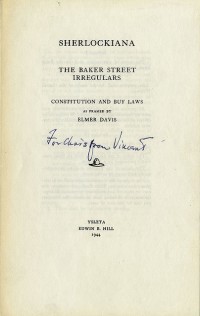
The Baker Street Irregulars was founded — or at least came out publicly — on January 6th, 1934, a date exegetically determined by the organization’s founder, writer and critic Christopher Morley, to be Holmes’s birthday. It’s no coincidence that the BSI went public shortly after the repeal of Prohibition in the United States: the group was, as Morley put it, largely a “whiskey and sodality.” Born in Christ Cella’s speakeasy in mid-town New York, it maintains a culture of boisterous — even ribald — literary camaraderie. The first “Buy-Law” of its 1934 Constitution mandates a series of canonical toasts, “after which the members shall drink at will.” This short sequence of rules concludes: “All other business shall be left for the monthly meeting,” and: “There shall be no monthly meeting.”
Membership in the BSI is by invitation only, usually in recognition of distinguished contribution to Sherlockian scholarship. There are currently some 300 active members, each invested for life with a title drawn from the canon that often bears some clever relation to the occupation of the person on whom it’s conveyed. The journalist Dirda, for instance, is invested with the title “Langdale Pike,” after the gossip columnist in “The Three Gables.” Neil Gaiman, a member since 2005, is invested as “The Devil’s Foot”; Isaac Asimov is “The Remarkable Worm.” The BSI has had two American presidents as members: Harry Truman and Franklin D. Roosevelt, who, in his “Baker Street Folio,” advanced the theory that Holmes was an American.
While the organization is incorporated, members pay no dues, and officers, including Michael F. Whelan, the current “Wiggins” (as the head of the organization is known), draw no salary. Its archives are housed at Harvard University, which seems like an endorsement of the group’s seriousness. This long and distinguished history is being chronicled in depth by Jon Lellenberg (“Rodger Prescott of Evil Memory”), a former Pentagon strategist who — an elementary deduction will show — is the mysterious “American” of David Grann’s 2004 New Yorker article “Mysterious Circumstances.” That article, in which Grann investigates the death by garroting of prominent Holmes scholar — and BSI member — Richard Lancelyn Green, proved that the world of Sherlockian scholarship is as rich and mysterious as the stories themselves. In fact, the BSI’s history is so dense that, though Lellenberg has thus far written five volumes, he’s only reached the 1940s. As Holmes himself once said, “Life is infinitely stranger than anything which the mind of man could invent.”
The BSI publishes an “irregular quarterly” of Sherlockian scholarship called the Baker Street Journal, but the group’s primary activity centers around an annual “birthday weekend” each January in New York, a series of meetings, luncheons, tours and lectures culminating in a dinner and Gaslight Ball. The festivities, punctuated with bawdy song and somewhat Rotarian-seeming proceedings, provides the opportunity, as Dirda puts it, to experience “an otherwise vanished era of literary bonhomie and frivolity.” It will surprise no one that several of these annual gatherings have taken place at the Algonquin Hotel.
The BSI’s breed of fraternal camaraderie is in keeping with the stories themselves. Holmes, as he himself notes, is lost without his Boswell: it’s been suggested that if Doyle had really wanted to kill Holmes, he would have thrown Watson off the Reichenbach Falls. “Watson,” Dirda writes, “is Holmes’s audience, the necessary spectator and butt of all those antic capers and dazzling feats of ratiocination.” The good doctor brings heart and conscience to Holmes’s machine-like brain, and a good part of the pleasure we take in the stories comes from watching this friendship develop and deepen.
Doyle’s genius, as Stefan Kanfer wrote in Time on Holmes’s 1987 Centennial, “was in creating a person not so different from ourselves — then splitting him in half. One part is a fallible, well-meaning soul who works at a job, wages the battle of instincts vs. ethics and sometimes goes wrong. The other is the person we would aspire to be: morally correct, financially independent and underweight. One feels; the other knows. One is real; the other ideal. Many labels adhere to this classic combination: ego and superego, desire and conscience, Watson and Holmes.” One might also add: Superman and Clark Kent, Huck and Tom, Tintin and Haddock, Aubrey and Maturin, Frodo and Sam, Butch Cassidy and the Sundance Kid, Calvin and Hobbes, and, in one of the more recent iterations, House and Wilson.
With Holmes and Watson, Conan Doyle essentially invented the “buddy” genre — the easy homosocial intimacy of Baker Street has a strange attraction. P.G. Wodehouse, creator of another famous pair — the foppish Bertie Wooster and his erudite butler Jeeves — was a self-described “Doyle man.” Wodehouse, a master of the art of dialogue, must have understood that while we may come to Doyle’s stories for the mysteries and stay for his cozy Victorian proscenium, it’s the good conversation that keeps us returning to 221B again and again.
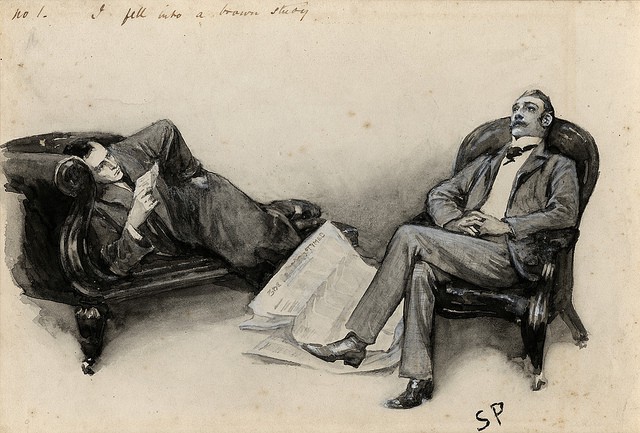
Sometimes, being privy to the pipe-befogged conversation of Holmes and Watson feels like spying on a closed society as inaccessible as the interior of a Masonic Lodge, and perhaps this exclusivity is part of the fascination. And it may be why one is not particularly surprised that membership to the BSI seems so mysteriously limited — and, like the world of Baker Street, almost exclusively male. The truth is that, sometimes, being a woman who loves Sherlock Holmes feels like a rather untidy proposition. It’s not as though Holmes returns one’s affection: “Women are never to be entirely trusted,” he warns at one point, “not the best of them.” Watson’s admiration of a well-turned ankle aside, the cozy, gas-lit world of Baker Street is strictly a boy’s club — imagining Holmes romancing a woman is about easily as picturing him chewing Nicorette. (Watson, who off-handedly claims to have “an experience of women which extends over many nations and three separate continents,” is another matter.) Ever true to its sources, BSI has traditionally been a stag party, not admitting women as members until 1991. (There were two exceptions; the first, in 1958, reportedly an accident. Lee Offord was likely admitted due to her androgynous name. In 1982, Lisa McGaw was given the title “Mrs. Hudson” in recognition of her services in organizing a BSI luncheon.)
Of course, there is one woman, “the woman” as she’s known, who cuts a figure in the tales: Irene Adler, the “adventuress” who outwits Holmes in “A Scandal in Bohemia.” The story begins:
To Sherlock Holmes she is always the woman. I have seldom heard him mention her under any other name. In his eyes she eclipses and predominates the whole of her sex. It was not that he felt any emotion akin to love for Irene Adler. All emotions, and that one particularly, were abhorrent to his cold, precise but admirably balanced mind. […] And yet there was but one woman to him, and that woman was the late Irene Adler, of dubious and questionable memory.
In 1943, Edgar Smith, then head of BSI, mandated that the annual dinner’s first “Conanical” toast be dedicated to “the woman,” and a living exemplar of Irene Adler honored. The first recipient of the “the woman” toast was Gypsy Rose Lee. Even as the guest of honor, Lee was only allowed to attend the pre-dinner cocktail party at which the toast was administered, before being retired for the evening.
Irene Adler also inspired a group of women at Albertus Magnus College in Connecticut to form the group The Adventuresses of Sherlock Holmes in the late ’60s. Led, then and now, by “Principle Unprincipled Adventuress” Evelyn Herzog, the organization mounted, as one of its first orders of business, a response to the BSI’s men-only policies. In 1968, six members of ASH formed a picket line outside Cavanaugh’s Restaurant on the night of the BSI’s annual dinner, demanding that women be offered full membership. In an unpublished history, cited in Christopher Redmond’s In Bed With Sherlock Holmes, ASH member Linda Patterson Ripley recollects that “some creative suggestions were brought forth for future attempts at breaching the Dinner, such as getting hired as waitresses or seeking entrance as a band of nuns coming to inquire about Cardinal Tosca; the most spectacular involved being wheeled in inside an 800-pound cake.” For years, ASH held rival, co-ed dinners on the same night as the BSI’s event.
Beginning in the mid-70s, a host of Sherlockian clubs were formed which were coed as a matter of course… The Red Headed League (for red-headed Sherlockians), The Blanched Soldiers (Sherlockian dermatologists), and The 140 Varieties of Tobacco Ash (which hosts privately-banded cigar dinners).
As Herzog wrote in an email to me, “The more egalitarian spirit of the years that followed, combined with the boom in Holmes-related popular culture, solved the practical problem for female enthusiasts.” Beginning in the mid-70s, a host of Sherlockian clubs were formed which were coed as a matter of course. There are now hundreds of these so-called “scion societies” worldwide, among them New York’s Five Orange Pips and Washington D.C.’s Half-Pay Club (in which Dirda also claims membership), as well as other, more outré offerings: The Red Headed League (for red-headed Sherlockians), The Blanched Soldiers (Sherlockian dermatologists), and The 140 Varieties of Tobacco Ash (which hosts privately-banded cigar dinners). T.S. Eliot — such an admirer of Holmes that he lifted a passage of “The Musgrave Ritual” wholesale for his Murder in the Cathedral — was an honorary member of The Trained Cormorants of Los Angeles. As coincidence would have it, Eliot also at one time shared an office at Faber & Faber with Frank Morely, the brother of the BSI’s founder.
Convergences like these are evidence of just how ubiquitous Holmes has become: it may be possible, should anyone care to try, to connect him directly to more or less every prominent person of letters in history by fewer than six degrees. And the detective’s Bacon-esque ubiquity extends well beyond the world of letters: “Because of the Baker Street Irregulars,” Dirda writes, “my friends now include a retired judge, a professional screen actor, a distinguished cardiac surgeon, the chief toxicologist of New York City, the owner of a Manhattan bookstore, the head of a university anthropology department, the former chief technical officer for Apple, an eminent rare book librarian, a long-time Pentagon strategist, several novelists and journalists, lots of lawyers, and the proprietors of two of my favorite small presses. If I’m ever in trouble, all I have to do is call on the Baker Street Irregulars.”
Having survived multiple attempts on his life, the passing of his era, as well as the emergence of other literary celebrities like James Bond, Holmes still holds a surprising amount of sway: we can picture the great detective, like his nemesis Moriarty, sitting like a spider in the middle of a cultural web of “a thousand radiations.” His web is so wide and his agency so great even beyond the world of fiction that Sherlock Holmes might as well be as real as the Irregulars contend he is. His heirs, at least, have turned their brand of literary scholarship into a subject as interesting as the man who inspired it — a feat that is anything but elementary.
Jenny Hendrix is a freelance writer living in Brooklyn. Some of her work is over here.
Photo of Sherlock Holmes statue by dynamosquito. Historic images courtesy of the Toronto Public Library Special Collections.
Steve Berke Will Not Be the Mayor of Miami Beach (For Now)

The small-town mayoral campaign covered everywhere from Maxim to the Times has ended with the easy reelection of the incumbent and with unimpressive voter turnout. 72-year-old Miami Beach mayor Matti Bower received 59.4% of the vote for her final term, which represents all of 4,096 votes. (In total, 6,888 people voted; of those, comedian-and-reality-show-dude challenger Steve Berke received 1612, almost a quarter.) Berke’s entry into the race, with the management of Roger Stone (yes, him) was intended to engage younger voters, to promote Miami Beach as a hip resort town and to rile up the city. Berke’s latest strategies were pretty vicious: his literature touted his Yale degree and referred to Bower as a high school dropout, and, for a pro-nightclub and pro-party candidate, he’s come out real hard against Urban Beach Weekend, wherein black people from all over the country fill up the town’s expensive hotel rooms and bring a great influx of cash to the city and non-black people complain about it and then the police harass, detain and/or shoot the visitors. Whether it was that message, or union support of the incumbent, or whether voters were not willing to be moved, it didn’t result in a victory.
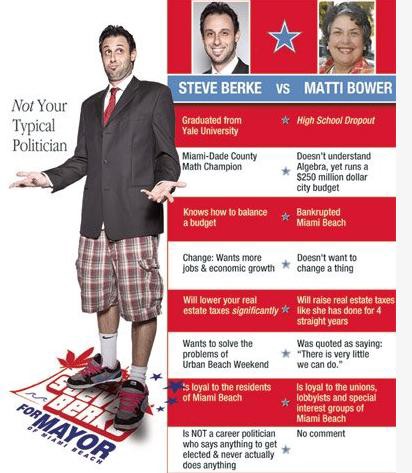
But if, perhaps, new voters did turn out, then previous voters stayed away, because only 88% of the number of voters came out this election compared to 2009. In 2009, Bower received 5768 votes, out of 7764–76.5% of the vote. So Berke, to his credit, did do some damage. Thankfully, the next election can’t possibly be as nasty. (OR CAN IT.)
Berke’s party, called The After Party, is supposed to be a Libertarian-leaning model of getting young people in office in smaller towns with nightlife industries; they’ve been scouting for candidates in other cities, including in California, but they have some kinks to work out. Getting people under 50 to turn out to vote isn’t a cinch; Berke’s exhausted face at his non-victory party last night is evidence of that.
Berke has already promised on Facebook he’ll run again in 2013 — with no incumbent to oppose him. That means he gets a year off, during which time his people will likely edit down the thousands of hours of video he’s shot and try to make a show out of it.
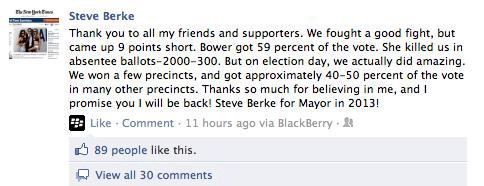
Terrible Browser's Terminal Decline Proceeding Apace
“A couple of interesting things happened in the world of Web browser usage during October. The more significant one is that Internet Explorer’s share of global browser usage dropped below 50 percent for the first time in more than a decade…. Internet Explorer still retains a majority of the desktop browser market share, at 52.63 percent, a substantial 1.76 point drop from September. However, desktop browsing makes up only about 94 percent of Web traffic; the rest comes from phones and tablets, both markets in which Internet Explorer is all but unrepresented. As a share of the whole browser market, Internet Explorer has only 49.58 percent of users. Microsoft’s browser first achieved a majority share in — depending on which numbers you look at — 1998 or 1999. It reached its peak of about 95 percent share in 2004, and has been declining ever since.”
The New Julian Barnes Is Worth It
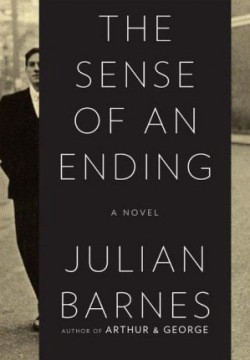
If you’re looking for something to culture up your weekend, you could do worse than carve out a couple of hours to read Julian Barnes’ Booker Prize winner, The Sense of an Ending. This is actually a decent starting place for those who have not read any Julian Barnes before: it deals with many of the same themes that populate most of his work, and at a brief 176 pages it’s a fair indicator of whether or not you’ll want to read his longer, better books. Which is to say that, no, this one is not his best: the ending feels somewhat forced and the main character is occasionally irksome in ways that a writer as talented as Barnes should have taken more care to avoid. But for all that, it’s a very satisfying book. It’s a meditation on memory, on aging, on the lies we tell ourselves in order to continue living with ourselves. It’s about all the issues we face as we trundle toward the tomb. It’s good reading for a gloomy Sunday. Go for it!
Another Reason To Congratulate Yourself For Living In The City
“Along with the now-familiar candles, downed trees across the driveway and the thawing hamburger meat taken from the freezer and tossed in the trash, the region’s latest freak storm, which left three million people without electricity, has left something else in its wake: increasing unease about just what is going on and what it means for the vast majority outside the relative stability of an underground urban power grid. No one can know for sure if this is just the eternally unpredictable chaos of weather on earth or it is something more ominous; call it the new abnormal. But in recent years, suburban and rural residents have found themselves facing multiple disruptions like Mr. Frohne’s. Experts say the violent weather of the past few years in the Northeast is stressing the 20th century above-ground utility grid as never before, along with the people who depend on it. Few solutions are in sight.”
The Saddest Story I Know
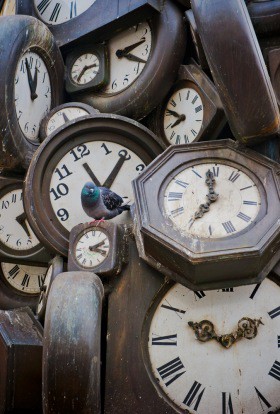
I cannot tell you the saddest story I know, because it was passed along to me by someone who is under the obligation of professional ethics to not share it for publication. But, in a larger sense, I can of course tell you the saddest story I know: It is yours. Oh, sure, you can pretend that I don’t know you that well, but, really, you’re not that special. You’re just like the rest of us. Your life is wracked with recrimination and regret, and even in those rare moments when you can somehow convince yourself that you are mostly a good person, you know that you are only a careless remembrance away from recalling just how terribly you’ve treated someone whose only wish in this life was to love you and be loved by you. You’re a monster. We all are. There are nights when we wake with a start and recollect just how terrible we were, wishing only that we could undo the past and set things right. Unfortunately, we are not given that power. We are here to suffer, to constantly confront our capacity for cruelty, and we do not receive respite until the day we finally do the decent thing and die. But this weekend, at least, we get to turn time back an hour. I guess that will have to be enough.
Photo by javarman, via Shutterstock
The Artisanal Meth Movement
“Police across the U.S. are struggling with a proliferation of busts for methamphetamine production, fueled by the rise of small but dangerous ‘one pot’ labs. The increasingly popular technique has largely replaced the kitchen-size meth lab with a single, two-liter soda bottle. Ingredients for a batch can easily be obtained on a single trip to a pharmacy and mixed almost anywhere.”
